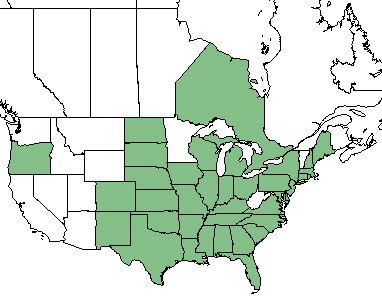Difference between revisions of "Triplasis purpurea"
(→Ecology) |
|||
| Line 1: | Line 1: | ||
{{italic title}} | {{italic title}} | ||
| + | Common names: purple sandgrass<ref name= "USDA"> [https://plants.usda.gov/core/profile?symbol=CEAM USDA Plant Database]</ref> | ||
<!-- Get the taxonomy information from the NRCS Plants database --> | <!-- Get the taxonomy information from the NRCS Plants database --> | ||
{{taxobox | {{taxobox | ||
| Line 31: | Line 32: | ||
==Ecology== | ==Ecology== | ||
===Habitat=== | ===Habitat=== | ||
| − | Common habitats for ''T. purpurea'' include Dunes, maritime dry grasslands, and open sandy areas. <ref name= "Weakley"> Weakley, A. S. (2015). Flora of the Southern and Mid-Atlantic States. Chapel Hill, NC, University of North Carolina Herbarium.</ref> | + | Common habitats for ''T. purpurea'' include Dunes, maritime dry grasslands, and open sandy areas. <ref name= "Weakley"> Weakley, A. S. (2015). Flora of the Southern and Mid-Atlantic States. Chapel Hill, NC, University of North Carolina Herbarium.</ref> It is considered a weedy species that can develop in disturbed areas such as old fields that have not been without agricultural use for long. <ref name= "jenkins">Jenkins, R. A., and Patrick D. McMillan (2009). "Vascular Flora of Sandhill Research and Education Center, Richland County, South Carolina." Castanea 74(2): 168-180.</ref> |
| − | Some samples have been taken from | + | Some samples have been taken from dry loamy sand in longleaf pine woods, roadsides, flatwoods, sand dunes, hammock clearing, slash pine woodlands, guld coastal plain, oak sand ridge, and other moderately disturbed sites. <ref name = "FSU herbarium"> URL: http://herbarium.bio.fsu.edu. Last accessed: June 2018. Collectors: Loran C. Anderson, Ed Keppner, Lisa Keppner, A.H. Curtiss, R.K. Godfrey, R.E. Perdue, R.Kral, Jacque Brennan, Melanie R. Darst, R.F. Thorne, R.A. Davidson, R.S. Mitchell, Gwynn Ramsey, H. Roth, V. Craig, Bill Boothe, Thomas Miller. States and counties: Florida (Clay, Bay, Wakulla, Jefferson, Duval, Okaloosa, Brevard, Franklin, Washington, Dixie, Walton, Union, Suwannee, Nassau, Gadsden, Liberty, Leon, Lee) Georgia (Thomas)</ref> |
<!--Natural communities, human disturbed habitats, topography, hydrology, soils, light, fire regime requirements for removal of competition, etc.--> | <!--Natural communities, human disturbed habitats, topography, hydrology, soils, light, fire regime requirements for removal of competition, etc.--> | ||
<!--===Phenology===--> <!--Timing off flowering, fruiting, seed dispersal, and environmental triggers. Cite PanFlora website if appropriate: http://www.gilnelson.com/PanFlora/ --> | <!--===Phenology===--> <!--Timing off flowering, fruiting, seed dispersal, and environmental triggers. Cite PanFlora website if appropriate: http://www.gilnelson.com/PanFlora/ --> | ||
Revision as of 19:35, 19 June 2018
Common names: purple sandgrass[1]
| Triplasis purpurea | |
|---|---|
Error creating thumbnail: Unable to save thumbnail to destination
| |
| Photo by John Hilty hosted at IllinoisWildflowers.info | |
| Scientific classification | |
| Kingdom: | Plantae |
| Division: | Magnoliophyta - Flowering plants |
| Class: | Liliopsida - Moncots |
| Order: | Poales |
| Family: | Poaceae |
| Genus: | Triplasis |
| Species: | T. purpurea |
| Binomial name | |
| Triplasis purpurea (Walter) Chapm. | |

| |
| Natural range of Triplasis purpurea from USDA NRCS Plants Database. | |
Contents
Taxonomic Notes
Synonym: T. intermedia (Nash)
Variety: none
Description
T. purpurea is an annual graminoid of the Poaceae family that is native to North America. [1]
Distribution
T. purpurea is found throughout the continental U.S. except Washington, California, Nevada, Arizona, Utah, Idaho, Wyoming, Montana, and Minnesota. It is also found in Ontario. [1]
Ecology
Habitat
Common habitats for T. purpurea include Dunes, maritime dry grasslands, and open sandy areas. [2] It is considered a weedy species that can develop in disturbed areas such as old fields that have not been without agricultural use for long. [3]
Some samples have been taken from dry loamy sand in longleaf pine woods, roadsides, flatwoods, sand dunes, hammock clearing, slash pine woodlands, guld coastal plain, oak sand ridge, and other moderately disturbed sites. [4]
Conservation and Management
Cultivation and restoration
Photo Gallery
References and notes
- ↑ 1.0 1.1 1.2 USDA Plant Database
- ↑ Weakley, A. S. (2015). Flora of the Southern and Mid-Atlantic States. Chapel Hill, NC, University of North Carolina Herbarium.
- ↑ Jenkins, R. A., and Patrick D. McMillan (2009). "Vascular Flora of Sandhill Research and Education Center, Richland County, South Carolina." Castanea 74(2): 168-180.
- ↑ URL: http://herbarium.bio.fsu.edu. Last accessed: June 2018. Collectors: Loran C. Anderson, Ed Keppner, Lisa Keppner, A.H. Curtiss, R.K. Godfrey, R.E. Perdue, R.Kral, Jacque Brennan, Melanie R. Darst, R.F. Thorne, R.A. Davidson, R.S. Mitchell, Gwynn Ramsey, H. Roth, V. Craig, Bill Boothe, Thomas Miller. States and counties: Florida (Clay, Bay, Wakulla, Jefferson, Duval, Okaloosa, Brevard, Franklin, Washington, Dixie, Walton, Union, Suwannee, Nassau, Gadsden, Liberty, Leon, Lee) Georgia (Thomas)